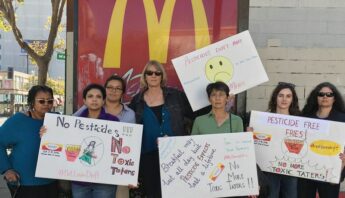For Immediate Release: April 29, 2014
Contacts:
Paul Towers, 916-216-1082, ptowers@panna.org
Tracey Brieger, 415-215-5473, tracey@pesticidereform.org
###
Groundbreaking Report: Hazardous Pesticides Used Near More Than 100,000 Children at California Schools
 Oakland, CA – Following the release of a groundbreaking California Department of Public Health (DPH) report analyzing agricultural pesticide use near California schools, children’s health advocates today released policy recommendations calling on officials to take immediate steps to protect the state’s schoolchildren from agricultural pesticides.
Oakland, CA – Following the release of a groundbreaking California Department of Public Health (DPH) report analyzing agricultural pesticide use near California schools, children’s health advocates today released policy recommendations calling on officials to take immediate steps to protect the state’s schoolchildren from agricultural pesticides.
“DPH’s quietly released report exposes a powerful problem,” said Sarah Aird, co-director of Californians for Pesticide Reform. “Hundreds of hazardous pesticides are applied, sometimes in very large quantities, near California’s classrooms—disproportionately near Latino children. Officials need to take swift action to protect schoolchildren from harmful pesticides.”
Californians for Pesticide Reform, a statewide coalition, brought the report findings to light at public events in five counties across the state today.
The detailed report “Agricultural Pesticide Use Near Public Schools in California” was posted to DPH’s website on Friday afternoon with little fanfare. The rigorous analysis shows that difficult-to-control pesticides, linked to negative impacts on children’s health and learning, are widely used near schoolchildren in fifteen of the state’s counties. This is the first time an analysis of pesticide use near schools has been conducted in California.
Children’s health advocates today released a summary of key findings in DPH’s groundbreaking report, as well as policy recommendations in “Protecting their Potential: Ensuring California’s school children are safe from hazardous pesticides.”
The DPH report’s robust analysis, funded by the US Centers for Disease Control and Prevention (CDC) and conducted in consultation with a wide range of health, industry and local government stakeholders, included these findings:
- Over 140 highly hazardous pesticides – those capable of causing cancer, reproductive and developmental harm and damage to the nervous system – were used in close proximity to schools.
- Over 118,000 students attend school in close proximity to the heaviest use of pesticides.
- Latino schoolchildren are 91% more likely than white students to be exposed to the highest levels of hazardous pesticides.
- The top five most hazardous pesticides used near schools are fumigants—the most dangerous pesticides on the market applied as gases to the soil before crops are planted. Fumigant exposure can cause cancer, reproductive and developmental harm and immediate poisoning.
According to the DPH report, the ten pesticides used in the greatest amounts near schools are all correlated with at least one harmful impact on children’s health and learning—and in most cases, multiple harmful impacts.
“Some of the pesticides used near California schools have been linked to deficits in cognitive skills, such as learning and memory, and in social skills, similar to those seen in autism spectrum disorder, based on studies in young children. It should also be noted that children spend about half of their waking hours at school, suggesting that these exposures may be as important as the pesticide products used in and around the home,” said Professor Irva Hertz-Picciotto, PhD, Deputy Director of the UC Davis Children’s Center for Environmental Health. “A growing body of research indicates that small amounts of pesticides can have long-lasting impacts on children’s learning and intelligence.”
While pesticides can also be harmful to adults, medical and public health experts warn that children may be in greater jeopardy.
“Children are especially vulnerable to the impacts of pesticides,” said Richard Jackson, MD, MPH, a pediatrician and former director of the Centers for Disease Control and Prevention’s National Center for Environmental Health. “They drink more water, breathe more air, and eat more food pound-for-pound than adults, so they absorb higher concentrations of pesticides.”
Within the past two years, both the American Academy of Pediatrics and the American Congress of Obstetricians and Gynecologists conducted thorough reviews of scientific studies and issued official statements urging a reduction in hazardous pesticide use in order to protect children’s health and well-being. These calls for action have taken on new urgency given the evidence released in DPH’s report.
“The problems facing schoolchildren don’t stop in fields and orchards,” said Margaret Reeves, PhD, senior scientist at Pesticide Action Network. “Many of the pesticides applied near schools are known to drift great distances during and after applications—sometimes up to weeks afterwards. Some of the pesticides of greatest concern are fumigants and neurotoxins such as chlorpyrifos.”
The pesticide chlorpyrifos is the eighth most commonly used pesticide near California’s public schools. Banned by US EPA in 2000 for home use because of the damage it can cause to children’s developing brains, it is still allowed for use in agriculture.
Children’s health advocates are calling on state and federal policymakers to take immediate action to protect children’s health and intelligence by reducing and eliminating the use of the most hazardous pesticides. Specific recommendations include:
- Make significant investments in research and support for growers to transition California to safe, sustainable replacements for fumigants and chlorpyrifos by 2020.
- Establish large “protection zones” around schools to maximize the distance between schools and pesticide applications.
- Require notification of schools and parents before applications of hazardous pesticides.
Unfortunately, agency officials missed an important opportunity last week to educate state legislators and influence policy change that could have protected school children’s health from pesticides by releasing the report on Friday. Last Thursday afternoon, the California Senate’s Agriculture Committee failed to pass legislation (SB 1411 – Jackson) requiring that homes and schools be notified in advance of applications of the most hazardous pesticides.
###
Californians for Pesticide Reform is a diverse, statewide coalition of over 185 member groups working to strengthen pesticide policies in California to protect public health and the environment. Member groups include public and children's health advocates, clean air and water groups, health practitioners, environmental justice groups, labor, education, farmers and sustainable agriculture advocates from across the state.
Related resources:
Protecting Their Potential (English)
Protegiendo Su Futuro (Spanish)







